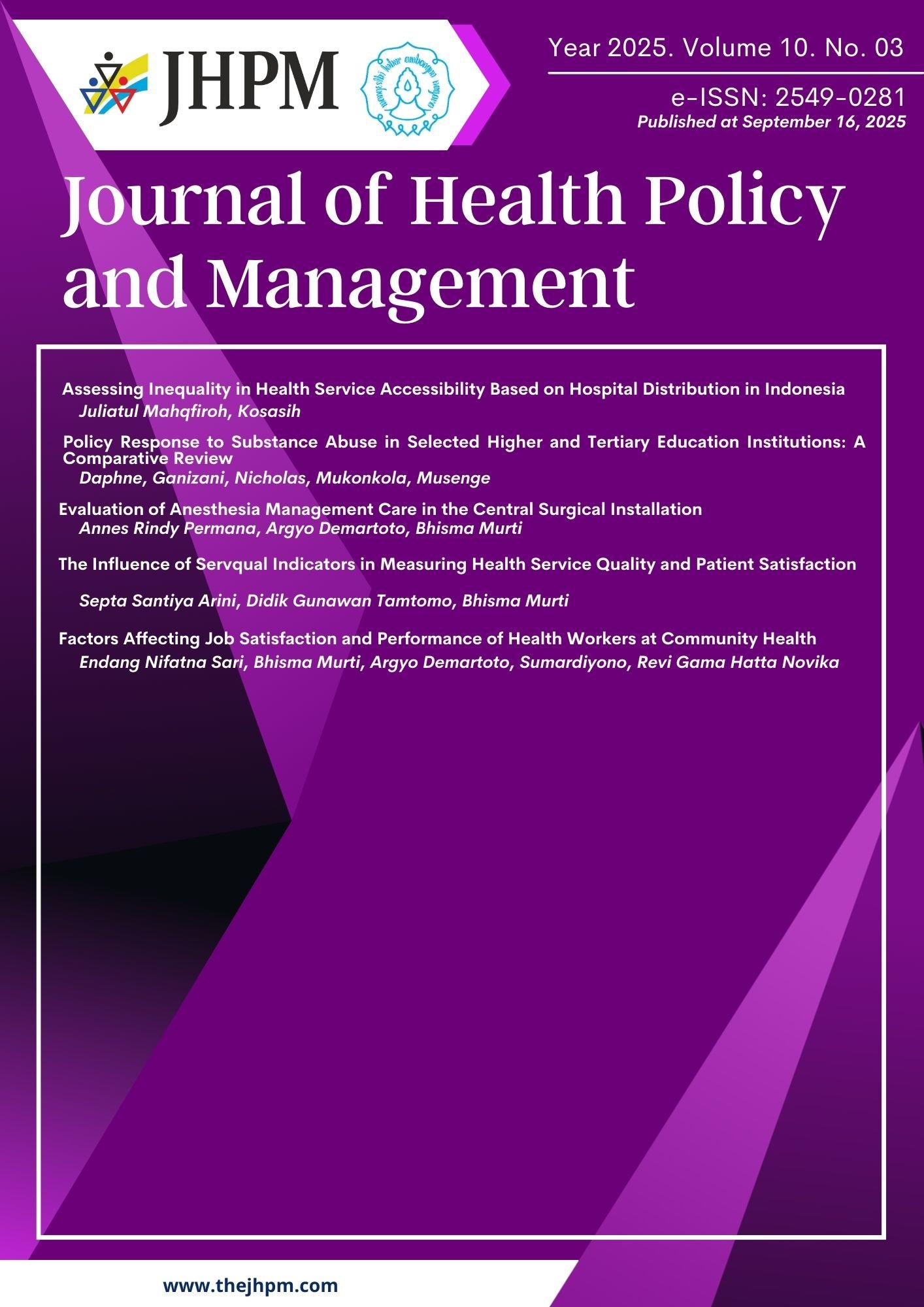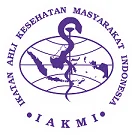Assessing Inequality in Health Service Accessibility Based on Hospital Distribution in Indonesia
DOI:
https://doi.org/10.26911/thejhpm.2025.10.03.01Abstract
Background: The distribution of health facilities is an essential indicator to improve public health services in Indonesia. However, the country’s archipelagic geography and uneven population density create challenges in ensuring equal access. This study aimed to analyze hospital distribution in Indonesia based on provinces and main islands to evaluate inequality in health service accessibility.
Subjects and Method: A comparative descriptive study was conducted using secondary data. Hospital data were obtained from the Hospital Information System (SIRS) of the Ministry of Health (2024), and population data were retrieved from the Central Statistics Agency (BPS) report (2023). A total of 3,209 hospitals were identified across 38 provinces and grouped into seven island clusters: Java, Sumatra, Sulawesi, Kalimantan, Papua, Maluku, and Bali–Nusa Tenggara. The population-to-hospital ratio was calculated, and hospital distribution was further analyzed by province, island, and hospital class.
Results: Java accounted for the largest number of hospitals (1,622) due to its high population and better infrastructure. In contrast, Eastern regions such as Papua (73) and Maluku (53) showed limited availability. Inequalities were also found in hospital classes, where advanced hospitals (Class A and B) were concentrated in Java, while peripheral regions were dominated by Class C and D facilities. This disparity forces residents in remote areas to travel long distances for adequate care.
Conclusion: Unequal hospital distribution highlights the urgent need for equitable health infrastructure development and strategic resource allocation policies to ensure fair access to health services across Indonesia.
Keywords:
accessibility, healthcare facilities, hospital distributionHow to Cite
References
Achmad and Prayitno G (2020). Regional disparity in Western and Eastern Indonesia. Int J Econ Bus Adm, 8(4): 101–110. https://doi.org/10.35808/ijeba/572.
Buaq D and Lorensius L (2022). Internalization of Pancasila values in Catholic schools: Efforts to strengthen national commitment. Educ J Educ Cult Stud, 1(1): 47–59. https://jurnal.litnuspublisher.com/index.php/jecs/article/view/5.
Chen L, Chen T, Lan T, Chen C, Pan J (2023). The contributions of population distribution, healthcare resources, and transportation infrastructure to spatial accessibility of health care. Inquiry, 60: 469580221146041. https://doi.org/10.1177/00469580221146041.
Chowdhury J and Ravi RP (2022). Healthcare accessibility in developing countries: A global healthcare challenge. J Clin Biomed Res, 4(152): 2–5. https://doi.org/10.47363/JCBR/2022(4)152.
Hu P, Liu Z, and Lan J (2019). Equity and efficiency in spatial distribution of basic public health facilities: A case study from Nanjing metropolitan area. Urban Policy Res, 37(2): 243–266. https://doi.org/10.1080/08111146.2018.1523055.
Iamtrakul P, Chayphong S, Gao W (2024). Assessing spatial disparities and urban facility accessibility in promoting health and well-being. Transp Res Interdiscip Perspect, 25: 101126. https://doi.org/10.1016/j.trip.2024.101126.
Kobashigawa L, Mathias K, Amarnani A, Panush RS (2022). And high-quality and equitable care for all. Clin Rheumatol, 41(11): 3269–3273. https://doi.org/10.1007/s10067-022-06386-7.
Kurniawan A (2024). Infrastructure competitiveness of regencies and cities in Java Island. J Pendidikan Geografi, 28(1). https://doi.org/10.17977/um017v28i12022p1-13.
Laksono AD, Mubasyiroh R, Laksmiarti R, Suharmiati E, Sukoco N (2016). Accessibility of health services in Indonesia (in Indonesian). Yogyakarta: PT Kanisius.
Leosari Y, Uelmen JA, Carney RM (2023). Spatial evaluation of healthcare accessibility across archipelagic communities of Maluku Province, Indonesia. PLoS Glob Public Health, 3(3): e0001600. https://doi.org/10.1371/journal.pgph.0001600.
Makmuri A (2017). Infrastructure and inequality: An empirical evidence from Indonesia. Econ J Emerg Mark, 9(1): 29–39. https://doi.org/10.20885/ejem.vol9.iss1.art4.
Ministry of Health of the Republic of Indonesia. (2024). Hospital Information System (Sistem Informasi Rumah Sakit – SIRS). https://sirs.kemkes.go.id/fo/home/dashboard_rs.
Muharram FR, Sulistya HA, Swannjo JB, Firmansyah FF, Rizal MM, Izza A, Isfandiari MA, et al. (2024). Adequacy and distribution of the health workforce in Indonesia. South-East Asia J Public Health, 13(2): 45–55. https://doi.org/10.4103/WHO-SEAJPH.WHO-SEAJPH_28_24.
Myers BA, Fisher RP, Nelson N, Belton S (2015). Defining remoteness from health care: Integrated research on accessing emergency maternal care in Indonesia. AIMS Public Health, 2(3): 257–273. https://doi.org/10.3934/publichealth.2015.3.256.
Noor ZA, Sekarningrum TD, Sulistyaningsih T (2021). Urban-rural disparities: Equity in access to primary health care services for the elderly during the Covid-19 pandemic (Disparitas perkotaan-pedesaan: pemerataan dalam akses layanan kesehatan primer untuk lansia selama pandemi Covid-19). J Penelit Pendidik Indones, 7(4): 576–585. https://doi.org/10.29210/02021-1249.
Pravitasari AE (2015). Study on impact of urbanization and rapid urban expansion in Java and Jabodetabek Megacity, Indonesia. https://doi.org/10.14989/doctor.k19347.
Priatama RA, Rustiadi E, Widiatmaka, and Pravitasari AE (2022). Physical geographical factors leading to the disparity of regional development: The case study of Java Island. Indonesian J Geography, 54(2): 195–205. https://doi.org/10.22146/ijg.66729.
Rao K and Schmidt A (2023). Human resources for health in South-East Asia: Challenges and strategies. WHO South-East Asia J Public Health, 12(1): 1–3. https://doi.org/10.4103/2224-3151.386476.
Rodzi MF (2023). Infrastructure development and economic equity in Indonesia (Pembangunan infrastruktur dan pemerataan ekonomi di Indonesia). J Masyarakat Desa, 3(2): 151–163. https://doi.org/10.47431/jmd.v3i2.353.
Shehadeh KS, Snyder LV (2023). Equity in stochastic healthcare facility location. In: Eiselt HA, Marianov V, eds. Uncertainty in Facility Location Problems. Cham: Springer, 303–334. https://doi.org/10.1007/978-3-031-32338-6_12.
Tao Z, Wang Q (2022). Facility or transport inequality? Decomposing healthcare accessibility inequality in Shenzhen, China. Int J Environ Res Public Health, 19(11): 6897. https://doi.org/10.3390/ijerph19116897.
Tao Z, Wang Q, Han W (2021). Towards health equality: Optimizing hierarchical healthcare facilities towards maximal accessibility equality in Shenzhen, China. Appl Sci, 11(21): 10282. https://doi.org/10.3390/app112110282.
van den Heever NN (2016). The road into the future of health care: The importance of addressing access to health facilities in transportation infrastructure investment decisions. Independent Study Project Collection, 3009. https://digitalcollections.sit.edu/isp_collection/3009.
Wenang S, Schaefers J, Afdal A, Gufron A, Geyer S, Dewanto I, and Haier J (2021). Availability and accessibility of primary care for the remote, rural, and poor population of Indonesia. Front Public Health, 9: 721886. https://doi.org/10.3389/fpubh.2021.721886.
WHO. (2025). Urban health. Geneva: World Health Organization. https://www.who.int/news-room/fact-sheets/detail/urban-health.





